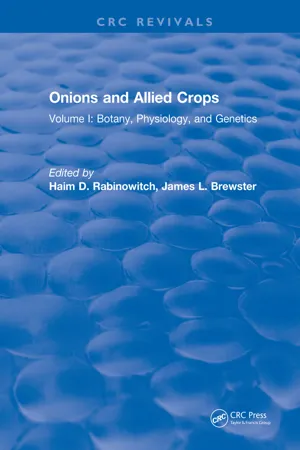Biological Sciences
Pollination
Pollination is the process by which pollen is transferred from the male reproductive organs of a flower to the female reproductive organs, leading to fertilization and the production of seeds. This transfer can occur through various agents such as wind, water, insects, birds, or other animals. Pollination is essential for the reproduction of flowering plants and the maintenance of biodiversity.
Written by Perlego with AI-assistance
Related key terms
3 Key excerpts on "Pollination"
- eBook - ePub
Strawberries
Production, Postharvest Management and Protection
- R M Sharma, Rakesh Yamdagni, A K Dubey, Vikramaditya Pandey(Authors)
- 2019(Publication Date)
- CRC Press(Publisher)
18 PollinationM.S. Khan , Poonam Srivastava, and R.M. Srivastava
CONTENTS 18.1 Flower Biology 18.2 Pollination Requirements 18.2.1 Pollen Production, Stigma Receptivity and Nectar Production 18.2.2 Modes of Pollination and Pollinizers 18.2.3 Pollinators 18.2.4 Floral Activity of Honey Bees 18.3 Managed Pollination Practices ReferencesPollination is an essential process in the lifecycle of most plants, and especially in higher plants such as fruit crops, as most of them require Pollination to ensure proper fruit setting. Pollination is the basis of genetic reconstitution and creation of variabilities for making improvement and evolving new varieties. Pollination is the process of transfer of pollen grains from anther on to the stigma of same flower (self-Pollination) or another flower of same plant species (cross-Pollination). Self-pollinated plant species can produce fruits but their number and quality are often improved when cross-pollinated. Cross-Pollination in crops has the potential to reduce loss and wastage of food so it could contribute to global food security (Klatt et al., 2014). To understand Pollination biology in a fruit crop such as strawberry, it is essential to have knowledge of various Pollination aspects such as floral biology, Pollination requirement, effective Pollination periods and the conditions, pollen germination, stigma receptivity, pollenizers, mode of Pollination and pollinators.18.1 Flower Biology
In strawberry, inflorescence is a modified stem and the flower cluster is a series of double-branches having one flower on each branch (Figure 18.1 - eBook - ePub
Thieves, Deceivers, and Killers
Tales of Chemistry in Nature
- William Agosta(Author)
- 2009(Publication Date)
- Princeton University Press(Publisher)
Getting Pollinated
3
Just as immobility forces plants to make special arrangements for dispersing their seeds, it also complicates their reproduction. No less than animals, flowering plants depend on bringing sperm and egg together to propagate their species. Their inability to move about presents the problem of how to bring these reproductive cells together. A plant’s sperm cells are carried in pollen grains that ripen on parts of a flower called anthers. Pollen must be transferred to another part of a flower, the stigma, before sperm and egg can come together. In some cases, a single plant or even a single flower might pollinate itself, that is, move pollen from an anther of one flower to the stigma of the same or a nearby flower. This is possible at times because individual plants of some species bear both male and female flowers or a single flower may afford both sexes. However, for most plant species where it is possible, self-Pollination—or inbreeding—is not a realistic option, as it does not lead to fertilization or at best furnishes inferior progeny. To set good seed, most plant species avoid inbreeding and require pollen from a different individual.As a result, plants have a quite different focus to their reproductive activities from that of most familiar animals. From butterflies to bowerbirds, animals pour great energy into sexual rituals that have one primary purpose: A male seeks to attract a receptive female and convince her of his superiority over competing males. To do this, perhaps he brings her a gift, wins a fight, or builds her a nest. By one means or another, he attempts to prove his excellence so the female will permit him to father her offspring. This face-to-face evaluation by the opposite sex has no place in the plant world. Here, successful reproduction is possible only if suitable pollen is somehow delivered from one plant to another, and so plants devote their energy to securing some third party’s assistance in carrying out this task. Unfortunately, outside pollinators are not always easily obtained. For nearly half the species biologists have investigated, third-party assistance is the limiting factor in natural reproductive success. For these species, the critical issue is not the weather, predation by seed-eaters, or the fertility of the soil, but simply whether a sufficient number of pollinators appear at the right time. Without pollinators, there will be no next generation. - eBook - ePub
Onions and Allied Crops
Volume I: Botany, Physiology, and Genetics
- H.D. Rabinowitch(Author)
- 2018(Publication Date)
- CRC Press(Publisher)
Chapter 6 Pollination Biology Lesley Currah Table of Contents I. Introduction II. The Onion Flower III. The Insect Pollinators IV. Pollination Investigations and Onion Breeding V. Pollinator Behavior on Onion Seed Crops in the Field VI. Pollination Biology and the Onion Breeding System Acknowledgments References I. Introduction Pollination biology is the study of the ways in which plants achieve Pollination and the influence of the events of Pollination on subsequent fertilization, seed production, and the progeny produced. Topics which it involves include plant and flower morphology, phenology (i.e., the timing of flowering and of the progress of flowering processes within the flower), the influences of weather and microclimate on flowering, and the interaction of these factors with the insect pollinators themselves. In insect-pollinated crops such as the onion, the kinds of pollinators attracted to the crop and their behavior are also studied. Pollination biology is therefore of considerable interest, to breeders and seed producers in particular. Much published work on the topic is of a descriptive nature, but a substantial body of experimental technique and data is being built up. The topic in onion has been well reviewed previously by Free, 1 McGregor, 2 and Waller. 3 The onion (Allium cepa L.), a plant only found today under domestication, is involved in a triangle of interactions involving two other vital components for its continued existence. Man, as the grower of the crop, maintains the onion as a valued food, and as seed production manager, selects from the population those plants which are to reproduce. Later, the farmer or seedsman also takes responsibility for the storage and distribution of the seed. The onion follows a growth cycle which is normally biennial: the edible bulb is produced after one season's growth, and this is the chief commercially saleable product
Learn about this page
Index pages curate the most relevant extracts from our library of academic textbooks. They’ve been created using an in-house natural language model (NLM), each adding context and meaning to key research topics.


